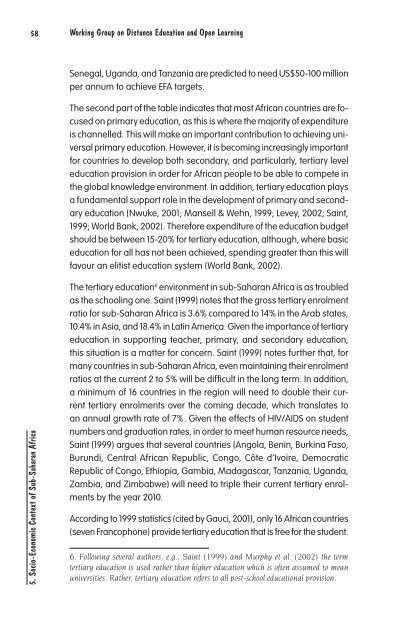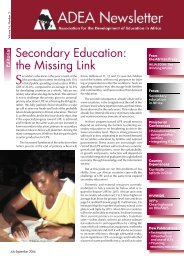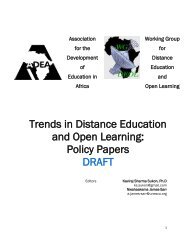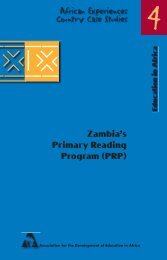Technological Infrastructure and Use of ICT in Education in ... - ADEA
Technological Infrastructure and Use of ICT in Education in ... - ADEA
Technological Infrastructure and Use of ICT in Education in ... - ADEA
You also want an ePaper? Increase the reach of your titles
YUMPU automatically turns print PDFs into web optimized ePapers that Google loves.
58 Work<strong>in</strong>g Group on Distance <strong>Education</strong> <strong>and</strong> Open Learn<strong>in</strong>g<br />
Senegal, Ug<strong>and</strong>a, <strong>and</strong> Tanzania are predicted to need US$50-100 million<br />
per annum to achieve EFA targets.<br />
The second part <strong>of</strong> the table <strong>in</strong>dicates that most African countries are focused<br />
on primary education, as this is where the majority <strong>of</strong> expenditure<br />
is channelled. This will make an important contribution to achiev<strong>in</strong>g universal<br />
primary education. However, it is becom<strong>in</strong>g <strong>in</strong>creas<strong>in</strong>gly important<br />
for countries to develop both secondary, <strong>and</strong> particularly, tertiary level<br />
education provision <strong>in</strong> order for African people to be able to compete <strong>in</strong><br />
the global knowledge environment. In addition, tertiary education plays<br />
a fundamental support role <strong>in</strong> the development <strong>of</strong> primary <strong>and</strong> secondary<br />
education (Nwuke, 2001; Mansell & Wehn, 1999; Levey, 2002; Sa<strong>in</strong>t,<br />
1999; World Bank, 2002). Therefore expenditure <strong>of</strong> the education budget<br />
should be between 15-20% for tertiary education, although, where basic<br />
education for all has not been achieved, spend<strong>in</strong>g greater than this will<br />
favour an elitist education system (World Bank, 2002).<br />
5. Socio-Economic Context <strong>of</strong> Sub-Saharan Africa<br />
The tertiary education 6 environment <strong>in</strong> sub-Saharan Africa is as troubled<br />
as the school<strong>in</strong>g one. Sa<strong>in</strong>t (1999) notes that the gross tertiary enrolment<br />
ratio for sub-Saharan Africa is 3.6% compared to 14% <strong>in</strong> the Arab states,<br />
10.4% <strong>in</strong> Asia, <strong>and</strong> 18.4% <strong>in</strong> Lat<strong>in</strong> America. Given the importance <strong>of</strong> tertiary<br />
education <strong>in</strong> support<strong>in</strong>g teacher, primary, <strong>and</strong> secondary education,<br />
this situation is a matter for concern. Sa<strong>in</strong>t (1999) notes further that, for<br />
many countries <strong>in</strong> sub-Saharan Africa, even ma<strong>in</strong>ta<strong>in</strong><strong>in</strong>g their enrolment<br />
ratios at the current 2 to 5% will be difficult <strong>in</strong> the long term. In addition,<br />
a m<strong>in</strong>imum <strong>of</strong> 16 countries <strong>in</strong> the region will need to double their current<br />
tertiary enrolments over the com<strong>in</strong>g decade, which translates to<br />
an annual growth rate <strong>of</strong> 7%. Given the effects <strong>of</strong> HIV/AIDS on student<br />
numbers <strong>and</strong> graduation rates, <strong>in</strong> order to meet human resource needs,<br />
Sa<strong>in</strong>t (1999) argues that several countries (Angola, Ben<strong>in</strong>, Burk<strong>in</strong>a Faso,<br />
Burundi, Central African Republic, Congo, Côte d’Ivoire, Democratic<br />
Republic <strong>of</strong> Congo, Ethiopia, Gambia, Madagascar, Tanzania, Ug<strong>and</strong>a,<br />
Zambia, <strong>and</strong> Zimbabwe) will need to triple their current tertiary enrolments<br />
by the year 2010.<br />
Accord<strong>in</strong>g to 1999 statistics (cited by Gauci, 2001), only 16 African countries<br />
(seven Francophone) provide tertiary education that is free for the student.<br />
6. Follow<strong>in</strong>g several authors, e.g., Sa<strong>in</strong>t (1999) <strong>and</strong> Murphy et al. (2002) the term<br />
tertiary education is used rather than higher education which is <strong>of</strong>ten assumed to mean<br />
universities. Rather, tertiary education refers to all post-school educational provision.

















